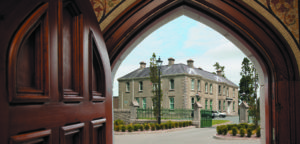THE ROMAN CATHOLIC CHURCH IN IRELAND TODAY
ADDRESS TO POLISH EPISCOPAL CONFERENCE, WARSAW
BY MOST REV SEAN BRADY, ARCHBISHOP OF ARMAGH AND PRIMATE OF ALL IRELAND
1 MAY 2004
It is both a pleasure and an honour for me to visit Warsaw and address the Polish Bishops’ Conference on this historic day. I thank you for the kind invitation to be here. As a citizen of the country that is currently host to the European Union Presidency, I warmly welcome Poland into the European Union. Today in Dublin, Poland returns officially to where it truly belongs, at the heart of Europe.
As President of the Irish Episcopal Conference I congratulate you and I bring you most cordial greetings from my fellow bishops. We rejoice at the prospect of belonging to the European Union of twenty-five (25) nations, which includes your country. We believe that Poland has much to teach the rest of Europe about tolerance and political freedom. We are aware of your long parliamentary tradition, going back to the fifteenth century, and of the part which you have played in paving the way for the expansion of the EU.
OUR TWO COUNTRIES HAVE MUCH IN COMMON
Although distant geographically, the histories of our countries are, in some respects, closely linked. In terms of a shared heritage and values, our countries resemble one another. Just as Irish monks kept the faith alive in parts of Europe in the latter years of the first millennium (AD), the Polish Church, inspired by the Holy Father in Rome, headed the drive in the latter years of the last millennium to dismantle the “Iron Curtain”.
Our two countries share troubled histories. Religious persecution has been visited on both our peoples. Our countries have both been colonized. While the Irish population was ravaged by famine in the mid-nineteenth century, Poland suffered the worst atrocities imaginable under Nazi occupation in the mid-twentieth century. Emigration has for centuries torn families and communities apart in both our countries. Both nations have had to struggle to regain an independent state. And of course, both populations are
predominantly Roman Catholic. Perhaps, because of both our countries’ experience of mass emigration and volatile relationships with our near neighbours, we have a strong sense of national identity. We both also
have a noble missionary tradition. During the last century the Polish and Irish worked well together in the Irish College in Paris.
When Ireland’s Celtic Chieftains fled from Ireland to find refuge in the Catholic countries throughout Europe, some settled in the Polish Commonwealth and served in the Polish military. One such man, Bernard O’Connor, became the royal physician to King Jan III Sobieski.
The 1916 uprising was an important moment in Ireland’s revolutionary history. Poland’s link with the Easter 1916 Rising is noteworthy. Married to Polish Count Markiewicz, Constance Gore Booth (Countess Markiewicz), played a leading role in the 1916 rising and became the Minister for Labour in the first Irish
government. I am told that there is a school here in Warsaw called after Countess Markiewicz.
NORTHERN IRELAND: THE NEED FOR RECONCILIATION
Nonetheless, Ireland has witnessed its own share of carnage in the last thirty-five years. More than three thousand lives have been lost in Northern Ireland which has a population of 1.5 million. The era of “The Troubles”, with all their community hatred and sectarianism has resulted in terrible atrocities. Fortunately, the intolerance of the last thirty-five odd years now appears to be diminishing. The Belfast Agreement of Good Friday 1998 is still recognised as the structure most likely to end, once and for all, centuries of tribal tensions in Northern Ireland. It has succeeded in bridging a gap between sectarian violence and political dialogue. Although the institutions of the Agreement are at present suspended, and the road to a fully functioning democratic society is not altogether agreed, the truth is that the killing has been dramatically reduced. But there is great need of reconciliation. We have much to learn from the people of Poland. Your willingness to forgive your neighbours after World War II should be an inspiration to us in Ireland to achieve the reconciliation which is so badly needed.
1979 PAPAL VISIT
We were tremendously honoured that the Holy Father decided to visit Ireland in 1979. He had already visited Poland and Mexico and chose to come to Ireland next because these three countries had suffered so much for the faith. Six months later the images of the Gdansk Lenin Shipyards, during the crucial strike of 1980, began to appear on our television screens. They depicted the locked shipyard gates and the workers barricaded behind the icon of the Black Madonna and the portrait of Pope John Paul II; along
with the pictures of priests hearing outdoor confessions just inside the shipyard gates.
Because Pope John Paul II had visited Ireland so recently and because just under one third of the population of the country had gathered in Dublin’s Phoenix Park to attend the Papal Mass and hear the Pope, there was great empathy for the Polish people. For only sixty five years earlier, Ireland had fought to create its first republic. So, there was genuine concern in Ireland for the people of Poland in their struggle to establish a third Polish republic in 1980.
1989: A NEW DEPARTURE IN POLAND AND IRELAND
Ireland’s recent economic success is indeed the result of its membership of the European Union. In 1990, the year Lech Walesa was elected President of Poland, the Irish economy was on the verge of financial collapse. Then a remarkable change took place. That turnaround is best exemplified by the rapid reduction in the unemployment rate. In 1994, the Irish unemployment rate stood at 18 percent. By 2000 the rate of unemployment had fallen to less than 5 percent. It was virtual “full employment.” As a result, the
dignity and self-esteem of a generation that had suffered large-scale emigration were restored. The prospect of a precarious life of dependency on state welfare benefits vanished, virtually overnight.
Despite this success, there are still large areas of poverty in cities and rural communities throughout Ireland. The income gap between high and low earners is now the widest in the Europe Union. Our young married couples are facing a daunting task to get their own homes.
Tragically, the young male suicide rate in Ireland is amongst the highest in Europe. The economic boom has brought many fruits to Ireland but there is a growing realisation that growth for growth’s sake may not sit well with a caring and an inclusive society. So when policy makers from Central and Eastern Europe visit Ireland to learn about the policies that resulted in the doubling of Irish Gross National Product between 1989 and 2001, they would also do well to learn from our mistakes. There is a growing risk that in the rush to improve our material well being, we are losing sight of our own identity.
RELIGIOUS BELIEF AND PRACTICE IN MODERN IRELAND
From 1850 until 1950, Ireland experienced a great religious revival. There was almost universal attendance at religious services and a high degree of acceptance of the moral authority of the Church. Confidence in the Church was very high also.
But times change. The last thirty years has seen a decline in the moral authority of the Catholic Church in Ireland, a certain loss of confidence in the Church and a decline in religious observance. Nevertheless, I think the Irish remain a religious people.
From the most recent statistics there is a near universal acceptance of belief in God. 96% of the people state that they believe in God. There are also high levels of belief in both life after death and Heaven. Only
9% of Irish people do not belong to any religious denomination. This figure remains low by International standards but it has risen very much in Ireland over the past 18 years.
There is strong evidence that Irish people wish to mark the important moments of their lives, such as birth, marriage and death with religious services and to publicly celebrate these events. The Irish attach considerable importance to prayer but increasingly they prefer to pray in private rather than in community.
While religious identity is still strong in Ireland it is, however, no longer synonymous with regular Church attendance. Last September an Irish opinion poll found that just 44 percent of those who regard themselves as Catholics attend mass once a week.
There is also increasing evidence that Church teaching in key areas of sexual ethics is progressively less influential in determining life style choices. There is a weakening in adherence to Catholic Church teaching on abortion, pre marital sexual relations, extra marital relationships and same-sex relationships.
The loss of confidence in the Catholic Church is a very serious issue. Clearly the sex abuse scandals which have recently come into the public forum and the manner in which they were perceived to have been handled have been a factor in the loss of confidence in the Catholic Church. Over the last ten years
the Church in Ireland has suffered a lot through sexual abuse of minors by priests and religious. The whole Church in Ireland has been hurt in recent years by this scandal. The number of candidates for priesthood and religious life has dropped dramatically. This decline was identified at the Second Synod for Europe as one of the signs of the existential anguish which accompanies a certain dimming of hope in Europe today.
IRELAND AND THE DRAFT EU CONSTITUTIONAL TREATY
“Ireland has an essential role to play in the construction of a new Europe and in confirming its profound identity,” so said the Holy Father to Ireland’s President McAleese, on her official visit to the Holy See last November.
My hope is that during its Presidency of the European Union, the Irish Government will play its part, not only in ensuring the retention of Article 51 of the Draft Constitution, but also in doing all it can to persuade its partners in the European Union to include a reference to God in the Preamble to the Constitution. Article 51 recognises the juridical status of Churches and of Religious Communities and the need for formal dialogue between the Churches and the Institutions of the European Union. The Irish Bishops’ Conference has already made representations to the Irish Government on this topic and on other issues, for example, the matter of stem-cell research on the human embryo. We look forward to working closely with the Episcopal Conference of Poland and with the other member Conferences to ensure the kind of Europe which we all desire. Together we will have to work for the growth of a mature culture of acceptance of immigrants which calls for the recognition of the fundamental rights of each immigrant.
TRÓCAIRE
Another issue on which we could all possibly co-operate is that of help to the developing nations. Trócaire, the Irish Catholic agency for world development, constantly reminds us that the overall level of development from the rich countries has dropped to an unacceptably low level. Poverty reduction, rather than poverty management, is fundamental to Europe’s future security. Perhaps together we can work to help to end the poverty which oppresses so many people in the developing world today.
CONCLUSION
I look forward to a Europe of good neighbours, whose citizens know the joy of living in peace with dignity, respect and justice. These are values which we all share already. May we continue to champion them as citizens of the enlarged European Union.
Laudetur Jesus Christus



You must be logged in to post a comment.